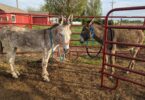Protect Your Precious Cargo
Getting off the farm and traveling to a new location can be a lot of fun. However, the risks to you and your horse may increase in unfamiliar surroundings. Trailering presents a whole new set of potential problems and safety hazards.
Learning about how things work, and what can go wrong, can help you prepare for and avoid potentially unsafe situations. Driving a horse trailer is different from simply driving your car—trailers have a wider turning radius and will need more time to accelerate, stop, and turn.
If you are not ready to buy your own rig (it can be a major investment), you can hire a professional to haul your horse for you. If you ride with a trainer or at a show barn, hauling may be a service that is offered.
Regardless of whether you are doing the hauling, or someone else is, it is important to understand as much as you can to ensure your horse is kept safe.
Hauling a live animal can be incredibly stressful. Know what you are signing up for and do everything you can to prepare to keep your equine partner safe.
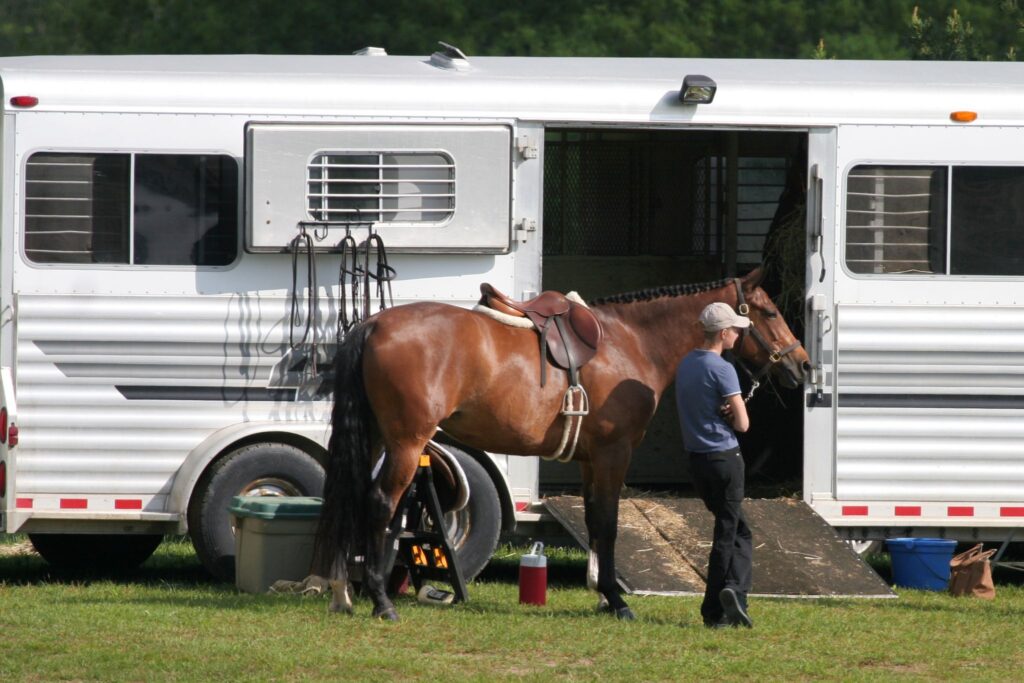
Source: Canva
Tow Vehicles
A towing vehicle must be rated to tow the trailer, fully loaded. A few terms to understand include:
- Payload: The maximum weight the vehicle is designed to carry. In our horse trailering example, this would include passengers, dogs, water, snacks, tack and equipment, and hay or anything else you may throw into the bed of the truck.
- Towing Capacity: The maximum weight the vehicle can safely tow. Be sure to calculate the loaded trailer, not the empty weight.
- Gross Combination Weight Rating (GCWR): This is the max total weight of the towing vehicle and the loaded trailer.
Learn more towing terms in our guide from Double D Trailers.
It is critical to know what the towing vehicle is rated to haul, and never exceed that limit.
If you are within 1,000 lbs of the vehicle’s max towing capacity, it would be wise to consider upgrading to a larger towing vehicle.
Want to learn more about horse trailers? We broke down 77 horse trailer models by weight to help you create the right rig combination.

Source: Canva
The type of terrain you will be driving on also affects your hauling capacity. A half-ton pickup truck may handle a 2-horse bumper pull trailer just fine in the Midwest. If you will be driving at an elevation over mountain passes, however, that truck may not have enough power to safely pull your rig.
Make sure the truck receiver ball matches your trailer hitch. A mismatch is a common reason for trailers to become disconnected from their towing vehicles.
Follow the same sequence, every time, when hitching up your truck and trailer. Do not skip steps, even if you are only going a short distance. Aside from damaging equipment and your horse, a loose trailer could seriously hurt other drivers.
Types of Horse Trailers
The main distinction between horse trailers is the attachment point to the towing vehicle. The two main types are bumper pull and gooseneck trailers.
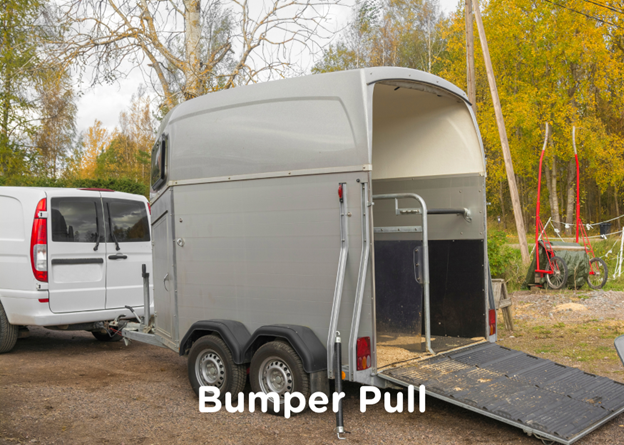
Source: Canva
Bumper pull trailers attach to a hitch near the bumper of the truck.
“Near the bumper” is an important distinction—you should never tow a horse trailer with a bumper-mounted hitch. The hitch for a bumper pull trailer should be welded onto the frame of the towing vehicle.

Source: Canva
Gooseneck trailers attach to a hitch welded to the truck’s frame located in the bed of the truck. Generally, gooseneck trailers are larger and require a bigger truck to pull them.
Note: In other parts of the world, specifically in Europe, horseboxes are much more common.
A Horsebox combines the tow vehicle and horse trailer into one unit.
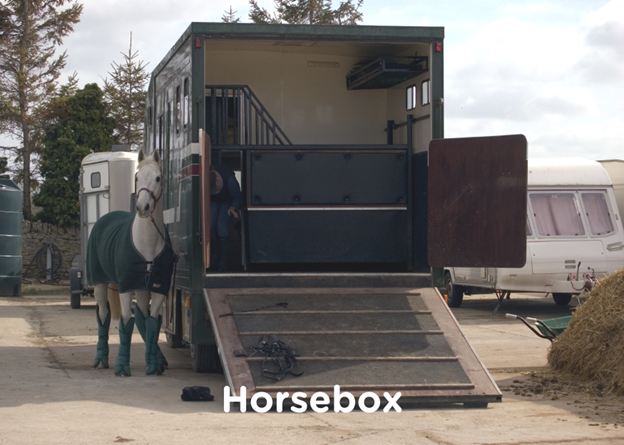
Source: Canva
Trailer Design
There are many design variations to consider when evaluating horse trailers. Some include:
Slant load vs. Straight Load – These refer to how the horses are loaded into the trailer.
If you have a straight-load trailer and are only hauling one horse, that horse should be on the left side. This minimizes the chance of the trailer tipping over, as roads are often designed to slope towards the edges for water drainage.

Source: Canva
A slant load trailer positions the horse at an angle, usually facing the center of the road.
A stock trailer is an open trailer—think of it as a stall on wheels. The horse can be tied or left loose.
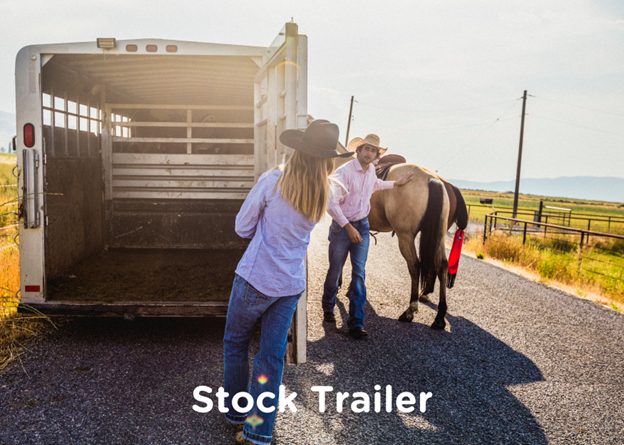
Source: Canva
Tack Room Design – Some trailers have a tack room (also referred to as a dressing room) at the front of the trailer, while others have a rear tack area. Some trailers have both!
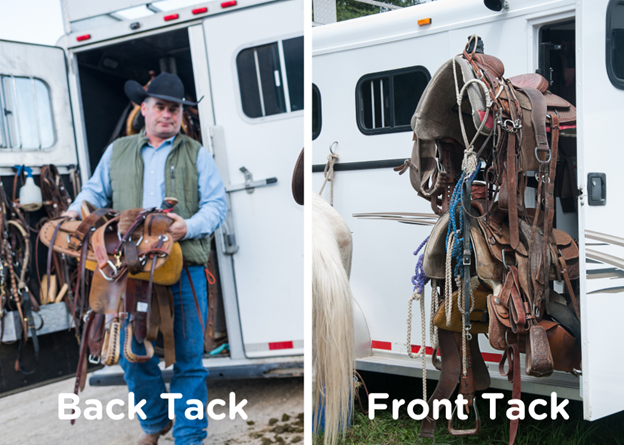
Source: Canva
Step Up vs. Ramp Option
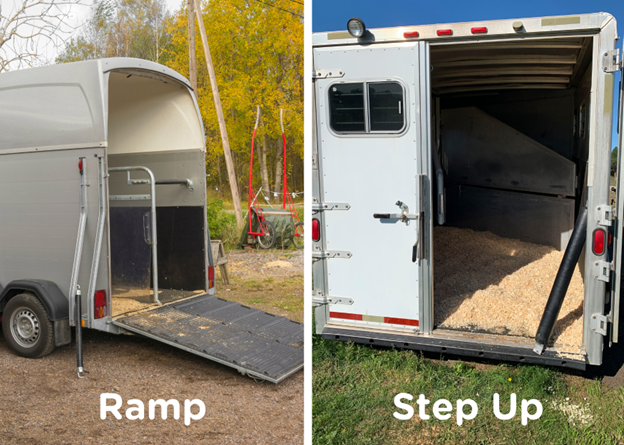
Source: Canva
Rear loading vs. Side Loading & Escape Doors – Most trailers have doors to load/unload from the rear of the trailer. Some trailers have large doors to load from the side of the trailer. Other trailers have escape doors in the sides of the trailer to provide more than one point of exit.
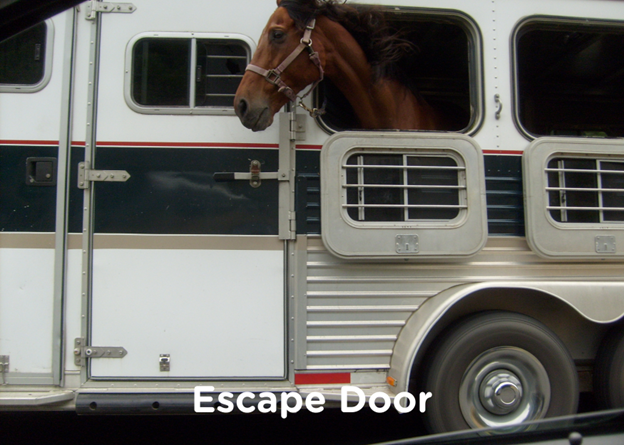
Source: Canva
Living Quarters – Some trailers have an area finished out like a camper, complete with a bed, kitchenette, and bathroom. These are more common to see at horse shows that last multiple days.
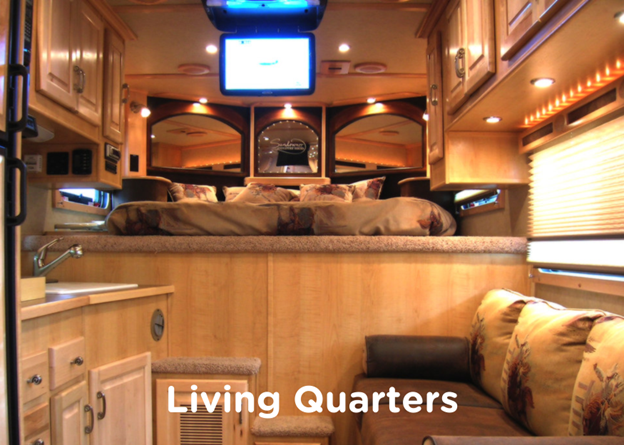
Source: Flickr
Trailering Do’s and Don’ts
- Never let your horse travel down the road with their head out the window. This is very dangerous for oncoming traffic, as well as the risk of flying debris damaging your horses’ eyes.
- If you opt to have the windows open for air flow (which may be necessary depending on the temperature!) be sure to have a screen in the window and/or haul your horse with a mesh fly mask for eye protection.
- Be prepared to drive slower than you normally would. Let other drivers pass you. Do not hang out in the left or passing lane. Brake early for stops and turns to minimize the effects on your horse.
- When driving for longer periods of time, stop to check on horses periodically and offer hay and water.
- Ensure you are hauling in temperatures that are safe.
- If it is very cold out, you may need to blanket your horse(s) for a trip and minimize the amount of air flowing through the trailer.
- If it is excessively hot, you may need to travel early in the morning or late at night and maximize air flow. Some trailers may have air conditioning, but this is more common in a living quarter area than the horse area.
- Think carefully about locking your trailer.
The hitch should always be locked when it is not attached to your vehicle as a theft deterrent.
Be cautious about locking the horse-part of your trailer. If you are stopping at a gas station, for example, and need to go inside, it may be a good idea to lock the trailer so no one can enter while you are out of sight.
If you are driving, it may be safer to leave the back doors unlocked (but securely closed) so in the event of an accident, emergency personnel can access the horses in the trailer.
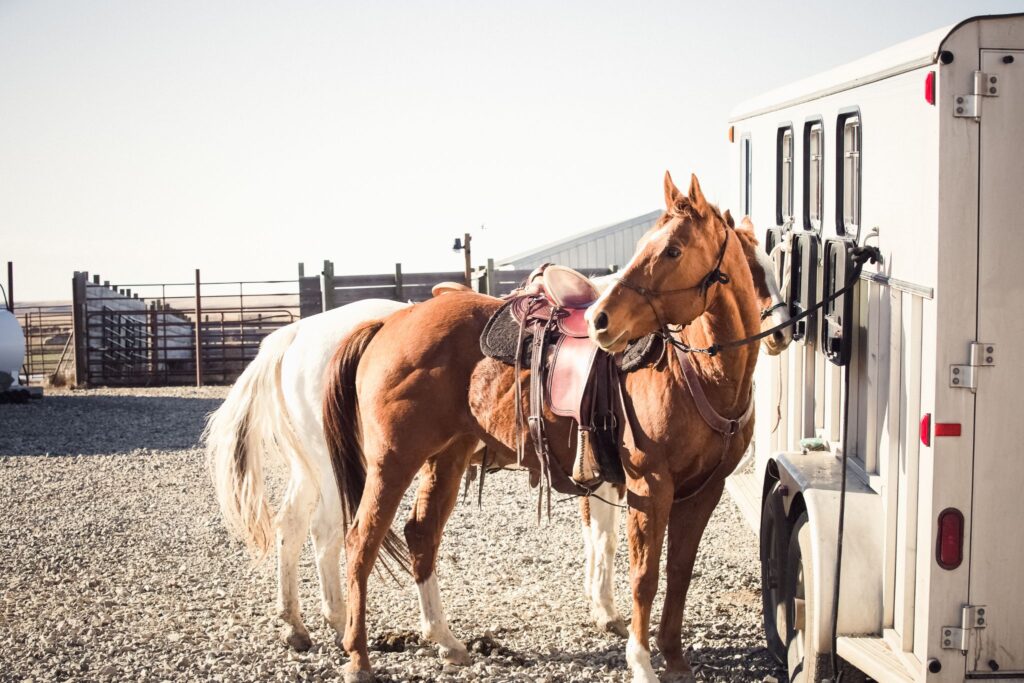
Source: Canva
- Make sure that everything in the tack area is secure and will not shift or fall during travel.
- If you haul with a hay net, make sure it is tied high enough off the ground. We recommend it as high as physically possible!
If a horse gets their leg or hoof caught in a hay net, it can cause serious soft-tissue injury with lasting consequences.
- We suggest keeping a pocket knife handy, as it could help you quickly cut the hay net loose before any harm is done.
- Trust your gut. If you have a bad feeling, find a safe place to pull over and do another safety check on your rig and wellness check on your horse.
- Always travel with both a horse and human first aid kit.
- Bring extra hay and water, in case something happens and you are delayed.
- Be aware of DOT regulations that may affect travel with your horse. For example, do you need a health certificate? Coggins test? Brand inspection?
- Make a trailer packing checklist (and use it!) so you never forget the essentials.
-
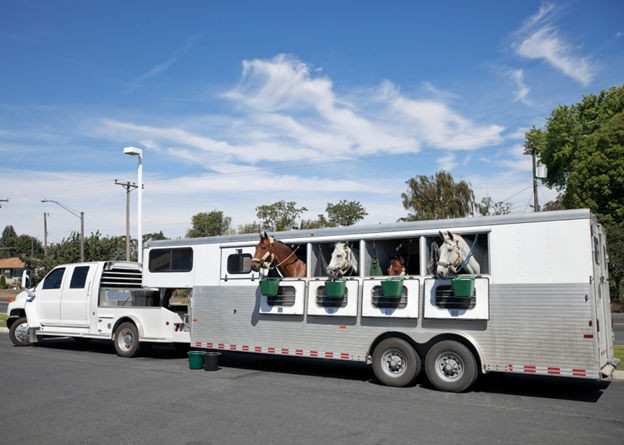
Never haul horses with their heads hanging out the windows! Photo Source: Canva
Trailering Safety Checks
You should know every feature and function of your horse trailer. Before hauling, always check:
- The hitch. Is the trailer correctly hitched to the truck? Are the safety chains properly attached and clear of the road? Chains dragging on pavement can create sparks, which could start a fire in dry areas.
- Are the lights connected and working properly? It can be helpful to have a buddy to check that brake and turn signals are all in working order.
- Check tire pressure, including your spare. Visually inspect the tire for signs of wear, nails, or other damage. Trailers often sit for long periods of time, which is not good for tire longevity and results in an increased risk of a blow-out.
- Check the floors and interior walls of the trailer for anything sharp or protruding that could injure your horse.
- It can be helpful to haul your horse with some protective equipment such as shipping boots or leg wraps. The type of leg covering will vary based on personal preference.
Here are a few different options:
Rookie Real Life:
- One horse used to paw incessantly the entire time he was in the trailer. He would paw until he rubbed the hair off his skin, even to the point of bleeding.
- This pawing action would remove leg wraps, then get tangled in them on the floor. This seemed like more of a safety hazard than leaving his legs unwrapped.
- The best wrap for hauling turned out to be a Professional’s Choice sports medicine boot. This was the only leg wrap that would stay in place during the trip and protect his legs from nervous behavior.
- Walking into a horse trailer can be scary for a horse—it is a sometimes dark, confined space. To make things easier, practice before the travel day.
- You can feed treats or grain inside the trailer to create a positive association.
- A few tips to make the loading process easier and safer:
- Make sure the trailer is well-lit so the horse can see exactly where they are going.
- Never load a horse into a trailer that is not already hitched to a vehicle.
- Always secure the door, butt-bar, or panel before tying your horse. If you tie your horse first, they could spook and pull back, creating a dangerous situation in a small space.
- Be aware of your location and your horse’s behavior at all times.
- Trailers are tight spaces, and you could easily be crushed against a wall if something goes wrong.
- Never stand in the trailer doorway while someone else is loading a horse—if the horse suddenly backs up, you could be run over.
- Keep the experience positive; it can be difficult to overcome a negative experience—for horse and human.
- Practice in advance!
Mario Johnson has an entire online course about Trailer Loading Your Horse. If you’re struggling, this is the perfect place to start.
There are calming supplements available that may help if you have a nervous horse. Another suggestion can be to haul with another calm, experienced horse—remember, horses are herd animals and do better in groups.
It is not recommended to sedate a horse before hauling, as the horse needs to be alert enough to balance when stopping, accelerating, and turning.
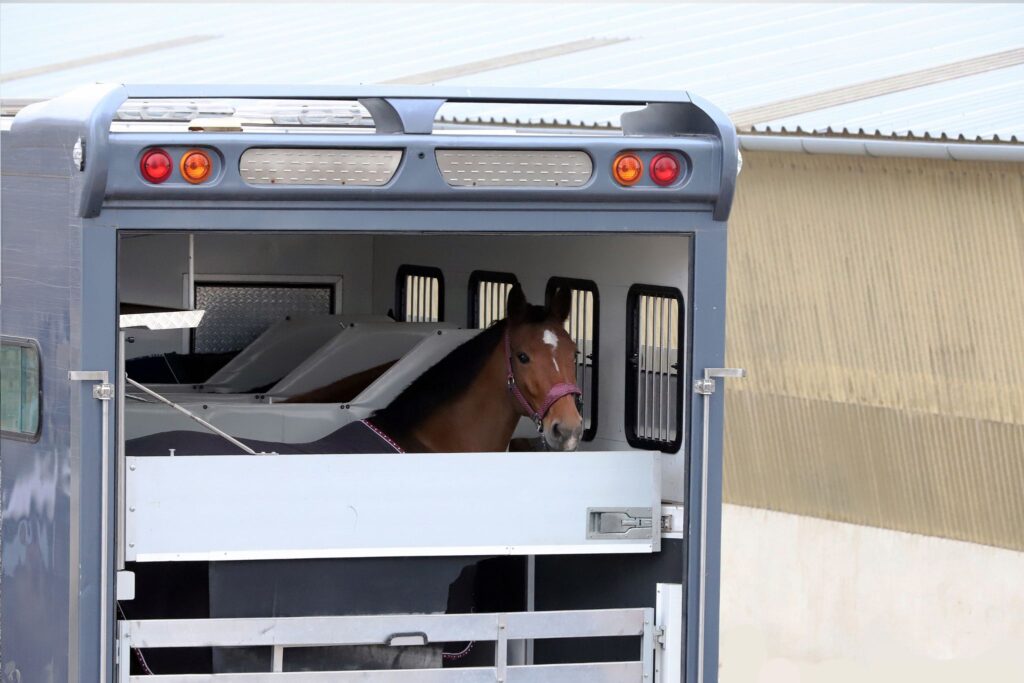
Source: Canva
Parting Thoughts
Trailering a horse can be intimidating at first, but remember–knowledge is power! These tips are a great starting point to learning to haul horses with confidence.
P.S. Enjoy this article? Trot on over to:
-
- Peace of Mind Horse Trailering: Tadi Bros Trailer Camera Review
- Horse Trailer Weights by the Numbers (77 Types & Models)
- 9 Best Horse Trailer Brands That Really Pull Their Weight
- 10 Best Bumper Pull Trailers of All Time
- Ultimate Packing and Horse Trailering Checklist
- Breaking Down Trailer Weigh Terminology
- You CAN Do This: Trailering a Horse for the First Time
- Trailer Loading Your Horse
- How To Safely Tie Horses in a Trailer
- 8 Best Horse Cameras (Including for the Trailer!)






